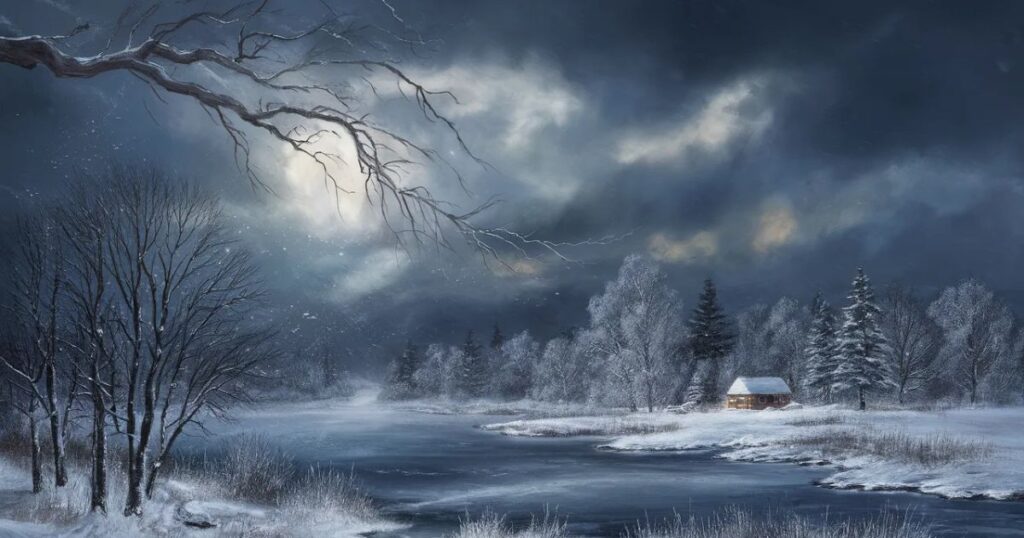Folks in Northern Minnesota and NW Wisconsin, listen up! The National Weather Service just issued a Winter Storm Warning that you can’t ignore. These severe weather alerts are serious business, signaling treacherous conditions that could disrupt your daily life in a major way.
A winter weather advisory is basically Mother Nature’s way of saying “Brace yourselves, a nasty storm is coming!” Whether it’s heavy snowfall blanketing the region, thick ice making travel treacherous, bone-chilling winds, or a wicked combo of all three, you need to take this warning seriously.
So what exactly are we dealing with here? Let’s break it down:
Areas in the Bull’s-Eye
The following counties are square in the crosshairs of this winter storm:
- Northern Minnesota: Cook, Lake, St. Louis, Koochiching, Itasca
- Northwest Wisconsin: Douglas, Bayfield, Ashland, Iron, Burnett, Washburn
Timeline: When to Expect the Worst
This winter blast is forecast to roll in late Thursday evening around 8 PM and continue pummeling the region until midday Saturday. So we’re looking at a long-duration event of over 36 hours of nasty weather.
The Wrath to Come
Don’t underestimate the hazards this storm could bring:
- Widespread heavy snow accumulations of 12-18 inches, with localized amounts up to 24 inches. That’s enough to bury a small car!
- Wind gusts up to 40 MPH creating blowing/drifting snow and whiteout conditions
- Possible ice accumulations of 1/4 to 1/2 inch, weighing down trees/power lines
- Dangerously low wind chills as frigid as -30°F
How This Storm Could Seriously Disrupt Life as You Know It
When a winter wallop like this takes aim, it can throw a massive wrench into your daily routines. Power outages, road closures, business shutdowns – it may feel like the world is grinding to a halt. Let’s look at some of the major potential impacts:
Lights Out High winds and ice buildup on power lines often leads to widespread outages during winter storms. Better have some backup lighting and heat sources ready, because you could be living like a 19th century settler for a few days! Say goodbye to that Netflix binge.
Driving Difficulties With heavy snow and ice-covered roads, driving will be extremely hazardous, if not impossible at times. Vehicle crashes spike by a staggering 142% during winter storms thanks to slick conditions. Unless absolutely necessary, it’s best to stay put and avoid the roads altogether when visibility is poor.
School/Business Closings Whiteout conditions and impassable roads? That’s a perfect recipe for school closures and many businesses being forced to shutter their doors temporarily. Enjoy those unexpected days off from work – or maybe not if you have cabin-fevered kids at home!
This storm has the potential to be one of the most crippling winter events the region has seen in years, reminiscent of the infamous “Holiday Blizzard” of 1999. That storm dumped over 2 feet of snow, stranded thousands of travelers, and left many residents without power for over a week. Not an experience anyone wants to relive!
Read More: PICUKI – VIEW INSTAGRAM CONTENT ANONYMOUSLY AND EDIT PHOTOS
Your Critical Winter Storm Preparedness Checklist
The key to riding out this storm safely is preparing BEFORE it hits. Once that first snowflake falls, it’ll be too late to get ready. Here’s your survival checklist:
- Stock up on essentials like non-perishable foods, water, medications, baby supplies, pet food
- Ensure you have the proper winter tools: shovels, roof rake, ice melt, sand for traction
- Wrap any exposed pipes with insulation to prevent freezing/bursting
- Weatherproof your vehicle with an emergency kit, warm blankets/clothing, sand/kitty litter
- Purchase or locate alternate heating sources like wood for fireplace
- Ensure you have ample supply of heating fuel, whether gas, oil, propane or firewood
- Protect outdoor faucets/water lines from freezing with insulators
- Gather warm bedding, layers of clothing to stay toasty if heat goes out
- Fully charge electronics and have backup power banks for smart devices
Here’s the catch – the time to take these precautions is NOW, before the first flakes start flying. Once you’re in the thick of blinding snow and bitter cold, it’ll be too late. As the old Minnesota adage goes, “There’s no such thing as being too prepared for a winter storm!”
Insider Tips for Riding Out the Storm Like a Local
While stocking up on supplies and hunkering down are wise moves, the hearty folks of Northern Minnesota and NW Wisconsin have unique tricks for not just surviving, but thriving during big winter storms:
“We always keep a big stack of board games and puzzles on hand. Throw a pot of chili on and it makes being stuck inside fun for the whole family!” – Judy Westman, Hayward, WI
Some turn their unheated greenhouse into a makeshift “warm room” by loading it with terracotta pots filled with candlewax that slowly release heat over time. Others have pickup truck tailgate parties, sharing laughs, stories and maybe an adult beverage over the truck beds.
“There’s nothing better than a good book by the fire when the snow is howling outside. Twist open the beverage of your choice and you’ve got winter figured out!” – Eric Lindquist, Ely, MN
No matter their methods, locals know the key is keeping safety top priority while embracing winter’s cozier side. With the right preparation and mindset, you can get through this storm in one piece too.
Staying Informed Throughout the Winter Storm Chaos
Keeping a steady stream of weather information coming in during the storm is crucial for monitoring the situation and knowing what hazards to expect next. Be sure to have these resources on hand:
TV/Radio Stations Local TV meteorologists and radio will be working 24/7 to provide live updates:
- WDIO News (Duluth)
- KBJR News (Duluth/Superior)
- KSTP Weather (Minneapolis/St. Paul)
Websites/Apps In addition to TV/radio, check these frequently:
- National Weather Service
- Weather apps like Dark Sky, AccuWeather, WeatherBug
- MN Department of Transportation road conditions/closures
- WI Department of Transportation
Social Media Accounts Local municipalities, transportation authorities and news outlets will be frequently posting updates to their social channels. Give them a follow:
- @NWSSuperior (Twitter)
- @MNDOT (Twitter)
- @CityofDuluth (Facebook)
Winter Storm Terms to Know
As you’re monitoring forecasts and alerts, familiarize yourself with these key winter weather terms:
Winter Storm Warning Issued when a combo of heavy snow, ice, and life-threatening wind chills are expected. This is as serious as it gets – delay travel and stay indoors if possible.
Winter Weather Advisory Issued when a hazardous winter weather event like freezing rain or moderate snow is anticipated that could impact travel.
Blizzard Warning Sustained winds of 35+ MPH along with snow and blowing snow reducing visibility to 1/4 mile or less for an extended period.
Wind Chill Warning/Advisory Issued for potentially dangerous wind chills of -25°F or lower. Minimize outdoor exposure.
Ice Storm Warning Ice accumulation of 1/4 inch or more is expected, which can severely damage trees/power lines and disrupt travel/power.
Key Takeaways: Heeding This Storm Warning Could Save Your Life
This massive winter storm barreling toward Northern Minnesota and Northwest Wisconsin is no joke. When weather alerts this serious are issued, complacency could prove disastrous. The hazards posed by heavy snow, ice, and punishing winds cannot be overstated.
By taking a few critical preparedness steps now before the storm hits and monitoring forecasts throughout Copy
Winter Storm Driving: When to Avoid the Roads
One of the most dangerous aspects of a winter storm is trying to drive in the hazardous conditions. With snow piling up, visibility poor, and roads like ice rinks, it’s often best to avoid getting behind the wheel if at all possible. But if you absolutely must travel, take extreme precautions.
Stay Off the Roads Unless Absolutely Necessary The safest strategy is to simply stay put and hunker down until the storm passes and roads are cleared/treated. If you can work from home, have supplies delivered, or postpone non-essential trips, that’s ideal. Getting stuck in whiteout conditions or sliding off an icy road is not worth the risk.
However, some travel may be unavoidable for jobs like healthcare workers, first responders, and critical business operations. If you must drive, take these safety measures:
Winterize Your Vehicle
- Install winter tires with thick tread designed for snow/ice traction
- Keep an emergency kit with blankets, snacks, water, sand/kitty litter, shovel
- Ensure windshield wipers, fluid, lights, battery are in good shape
- Clear ALL snow/ice from ALL surfaces before departing
Plan Your Route Carefully
- Check latest road conditions/closures before leaving
- Plan to take major roads/highways that are higher priority for plowing
- Let others know your route and expected arrival time
- Consider packing an overnight bag in case you get stuck
Drive Slowly, Defensively and Increase Following Distance
- Reduce speeds to under 45 mph, lower for poor conditions
- Leave triple the normal following distance for braking room
- Accelerate and brake very slowly to avoid sliding
- Do not use cruise control or forward collision warning on slick roads
Stay Alert and Avoid Distractions
- Keep headlights on and eyes constantly scanning surroundings
- Don’t fiddle with entertainment/device screens while driving
- Pull over in a safe area to handle calls, adjust routes, etc.
Following these precautions can help dramatically reduce risks, but there’s no 100% guarantee of safe winter travel. Delaying trips if possible until the worst conditions have passed is always the smartest move to protect yourself and others on the roads.
At Home: Staying Safe and Riding Out the Storm
Even if you don’t have to brave the roads, heavy snow, ice, and high winds from the storm can still pose risks at home. Prepare for the possibility of power outages and make sure your home is properly winterized to avoid bigger issues.
Power Outage Preparedness
- Have flashlights, battery-powered lamps/lanterns and extra batteries
- Consider a portable generator or alternate power/heating source
- Keep fridge/freezer closed to preserve food as long as possible
- Insulate rooms you’ll be sheltering in for warmth
- Dress in layers and use blankets/sleeping bags for added warmth
Proper Home Winterization
- Insulate any exposed pipes to prevent freezing/bursting
- Inspect for drafts and air leaks around windows/doors
- Protect outdoor faucets/water lines with insulators
- Have safe heating sources ready like firewood for fireplaces
- Keep sidewalks/stairs clear of snow/ice buildup
- Prune tree branches away from roof/power lines
Having the proper supplies, heated shelter area, and power backup if needed will help keep you and your family safe and comfortable while riding out the storm at home. Proper winterization also prevents costly home damage from occurring due to burst pipes, snow loads on roofs, and more.
Winter Fun While Stuck Inside Don’t let cabin fever set in! When stuck inside during a blizzard, find ways to pass the time and keep spirits up:
- Indoor games like board games, cards, charades
- Read books, do puzzles/crafts, bake treats
- Movie/TV marathons if you have power
- Kids can have indoor snowball fights or build blanket forts
- Embrace the hygge lifestyle – light candles, drink hot chocolate!
Getting a little stir crazy is inevitable if hunkered down for days, but leaning into quality family time makes the experience more memorable and fun. Think of it as a chance to unplug from the outside world’s busyness for a bit.
Spring Will Eventually Arrive! Shake Off the Winter Blues
After enduring a major winter storm event like this, some may start to feel the effects of seasonal affective disorder (SAD) or the “winter blues” as the frigid temperatures and lack of sunlight drag on. Here are some tips:
- Get outdoors for some fresh air and daylight when conditions allow
- Use light therapy lamps or a sunlamp
- Eat foods rich in vitamin D, or take supplements
- Exercise regularly to boost endorphins
- Socialize safely with friends/family, even if just virtually
- Consider light therapy or talking to a doctor if symptoms persist
While winter is harsh in the North, Spring will eventually thaw out the frozen tundra! Hang in there through the dark days. Before you know it, you’ll be packing up those snow shovels and salt spreaders for another year.

Charlis, with 6 years of experience, is a seasoned writer at Techno Krafter. He crafts engaging content with a knack for simplifying complex concepts, enriching readers’ understanding across various tech domains.







